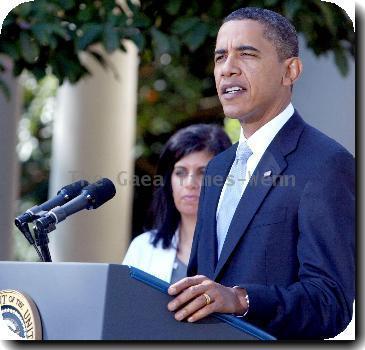Revised deal between Calif. conservationists and oil company allows more drilling, if approved
By Noaki Schwartz, APWednesday, April 7, 2010
Calif. conservationists, oil company strike deal
SANTA BARBARA, Calif. — Conservation groups on Wednesday unveiled a new version of an unusual agreement in which they will lobby for an oil company’s expansion of drilling off the coast of California in exchange for definite end dates to its local petroleum operations.
The revision attempts to address criticisms of the original 2008 agreement by making its terms public, granting the state the right to enforce it and strengthening provisions to ensure an end to operations offshore from scenic Santa Barbara County.
A week after President Barack Obama moved to open many federal waters to drilling — except along the West Coast — local environmental groups accompanied by area political leaders unveiled the revised plan at Shoreline Park on a bluff overlooking the blue Pacific with oil rigs in the distance.
“The bottom line is this plan puts in place a timetable to end existing oil drilling off our coast and prevent any future drilling,” said Rep. Lois Capps. “It’s transparent. It’s accountable. It’s smart.”
The plan, which needs government approval, would allow Plains Exploration & Production of Houston to slant drill up to 30 new shafts from an existing platform in federal waters into a formation in state waters.
The company, known as PXP, would shut down existing oil production from three offshore platforms in nine years and a fourth platform in 14 years. It would also remove two onshore support and processing facilities and hundreds of acres of onshore oil wells.
The environmentalist parties to the deal essentially do not view the plan as new drilling because it would use the existing Platform Irene.
Currently, 27 platforms operate off the Central and Southern California coasts. They produced 13.3 million barrels of oil in 2009, a very small amount of the overall national production.
Environmental Defense Center attorney Linda Krop, who represents the environmental groups, said the revised agreement would allow the California attorney general to enforce its terms by making the state a third-party beneficiary.
Backers also pointed to provisions requiring PXP to surrender its federal oil leases to eliminate the possibility that the four platforms could continue to operate after the end dates, and to prevent PXP from being forced by the federal government to continue producing.
Under the deal, PXP would also have to give up any profits resulting from a violation of the end dates.
Addressing another concern, the backers said there are no title or other issues to prevent PXP from turning over 3,900 acres on shore to the Trust for Public Land.
Despite such changes, some conservationists continued to doubt the proposal.
State Coastal Commissioner Sara Wan, whose board may eventually have to weigh in on the plan, had yet to read the new agreement but wasn’t sure it could bind the state into defending the deal.
“There’s no way you can tell the government 15 years from now that it can’t change its mind and do what it wants to do,” she said.
Assemblyman Pedro Nava, D-Santa Barbara, who is running for state attorney general, said the agreement does not give the state any additional authority.
“Bottom line for me, in 2008 we were told that the deal was the deal of the century and it wasn’t,” he said. “Why am I going to believe this one is any better than the last one?”
Richard Charter, energy consultant to Defenders of Wildlife, said that even though it is a local proposal, it threatens to open up the entire state coastline and is opposed by “most of the mainstream conservation community.”
Word of the initial 2008 agreement stunned the wider environmentalist community because of the involvement of such vigorous petroleum foes as the group Get Oil Out!, which was spawned by outrage over a 1969 platform accident off Santa Barbara that fouled miles of ocean and beaches with wildlife-killing goo.
At first, the deal garnered support from national groups such as the Sierra Club, which later withdrew its backing amid concerns that the contract was confidential and not enforceable. Eventually more than 100 groups opposed it.
In addition to the then-private nature of the agreement, commissioners and other environmental groups also raised concerns that the end date may not be enforceable. Others worried that approving the project could inadvertently open up the entire California coastline to new drilling, ending a 40-year moratorium.
Criticism was further heaped on supporters of the initial agreement after it was leaked early this year.
It doesn’t outline how much the Environmental Defense Center is getting paid, but in the previous contract PXP agreed to pay the groups’ fees and out-of-pocket-costs, as well as $50,000 up front and another $50,000 upon approval. In exchange, the environmental groups agreed to lobby in writing for the project and testify at public hearings before State Lands, Santa Barbara County and the California Coastal Commission.
In early 2009, the project was turned down during the public approval process at the State Lands Commission.
Since then, however, Gov. Arnold Schwarzenegger has twice tried to revive the project, most recently with a proposal to use money generated from the drilling to fund state parks.
The State Lands Commission and California Coastal Commission would have to approve the agreement before it would take effect.
The Santa Barbara coast has some of California’s most distinctive ocean vistas, encompassing the isles of Channel Islands National Park.
Santa Barbara Mayor Helene Schneider endorsed the revised local agreement.
“This plan will not only put a stop to existing oil operations, but will also help us stop new federal leasing by closing down and removing existing oil infrastructure,” she said.
Tags: Barack Obama, California, Coastlines And Beaches, Contracts And Orders, Energy, Environmental Activism, Land Environment, Natural Resource Management, North America, Santa Barbara, United States, Wildlife



